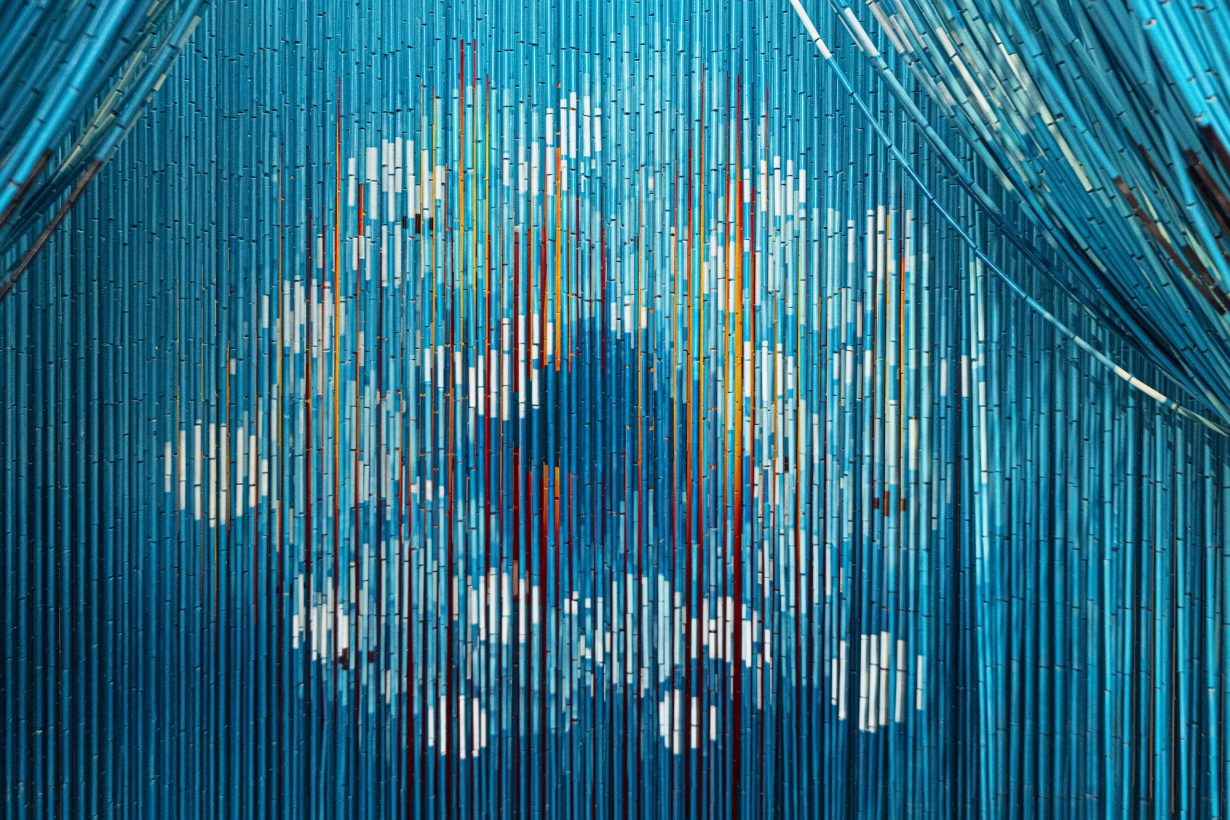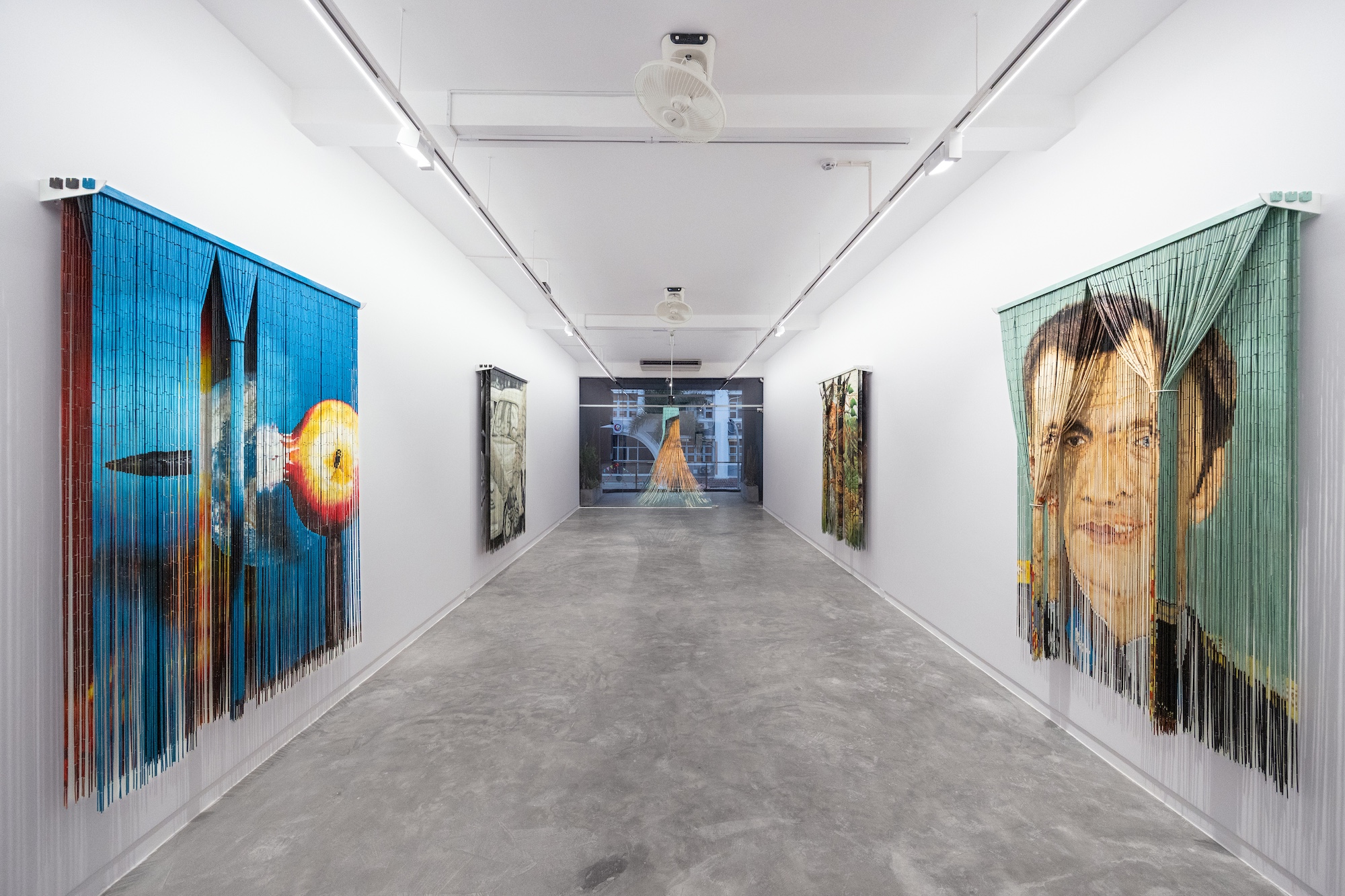In Fight or Flight or Float or Fall, Tuan Andrew Nguyen questions the erosion of social and material memory
To enter this exhibition, one must first pass through Pierced (all works 2024) – a single installation that features a series of painted bamboo curtains. Hung together, the strips of beaded bamboo nodes, coloured in a gradient of blues, form a shimmering surface that appears to oscillate between opacity and transparency. As you push your way through, they clack, signalling and surrendering to your movement. This work serves as an apt introduction to an exhibition that interrogates how material memory, etched on salvaged war remnants (including artillery shells and repurposed metal), both accumulates and disintegrates over time as the materials wear, erode and are continuously reshaped into new forms. Pierced is one of a series of works that use bamboo curtains as canvases for painting, including Bang, Frontier, Tear, Touch and Twirl. Four of these works are mounted against two walls, while Twirl – a cylindrical curtain – is suspended midair. Hanging from the ceiling, it spins in a precisely timed, ceaseless, motor-driven rhythm.
Some curtains part symmetrically like conventional drapes, cleaving an image down the middle, while others are drawn aside unevenly, distorting figures and landscapes into fragmented recollections. In Frontier, three layers of bamboo curtains simultaneously conceal and reveal one another, displaying superimposed portraits of astronauts: the Soviet Union’s Yuri Gagarin, who became the first human in space in 1961; Alan Shepard, the first American to follow; and Phạm Tuân, the first Vietnamese and Asian in space, in 1980. The layering of these figures collapses the historical timeline of space exploration and the intellectual space of opposing political ideologies. At the same time, it reminds us of the phrase the ‘bamboo curtain’, a term once used to define the political divide between communist countries in East and Southeast Asia – such as China, North Korea and North Vietnam – and the capitalist states of the rest of the region. The remaining works in this series, by the same token, are presented in varying formats, each offering a fractured portrayal of historical figures and spectacles: nuclear detonations, drawn from both actual historical events and imagination; fleeting visions of wildlife and ecological ruin; portraits of the invisible hands that forge history.

Artillery shells and old weapons provide the materials for the rest of the works on show. The items were excavated from Quảng Trị, the most heavily bombed region in the country during the Vietnam War and one that still contains its highest concentration of unexploded ordnance. Nguyen reconfigures these historical materials into various delicate hanging mobiles, echoing the informal networks of scavenging and recycling that sustain communities in the aftermath of war. A series of sculptures, Hover, Bird In Space and Time, crafted by Nguyen and his collaborators from pounded brass and artillery shells, feature large, stylised dragonflies suspended by the tips of their heads on a totemic structure, as if oscillating between poised stillness and imminent takeoff.
In the same vein, in the hanging mobiles 57MM #4 – Untitled and 57MM #1 – Untitled, 57mm artillery shell-casings are transformed into percussive instruments. Scarred and weathered by time, the patina of oxidation reflects a form of resistance against historical erasure. As history lingers in these repurposed relics, these instruments not only memorialise but also create countermemories within these discarded vestiges of war. When gently struck with a wooden mallet, these sculptures emit low, gonglike tones – resonant yet restrained, lingering briefly before fading into the surrounding space. Unlike the deafening blasts of war that once defined these materials, their sound is now recalibrated, carrying a placid, meditative quality. The reverberation remains clear, yet it is now softened, as if the oxidised brass is fatigued by its own history, offering a sound that is disarmed, almost hesitant – neither fully present nor entirely absent. The echoes of gunfire from the past – once dividing nations and redrawing maps – are now tamed, reincarnated – into something through which to contemplate, heal and reconcile.
Tuan Andrew Nguyen, Fight or Flight or Float or Fall, Galerie Quynh, Ho Chi Minh City, 24 December – 8 March
From the Spring 2025 issue of ArtReview Asia – get your copy.
